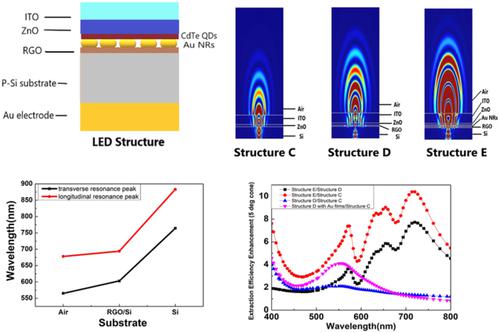当前位置:
X-MOL 学术
›
Luminescence
›
论文详情
Our official English website, www.x-mol.net, welcomes your
feedback! (Note: you will need to create a separate account there.)
Investigation of plasmon‐induced extraction efficiency enhancement in a CdTe‐based LED using FDTD simulation
Luminescence ( IF 3.2 ) Pub Date : 2020-11-11 , DOI: 10.1002/bio.3984 HongYu Wang 1, 2 , Dan Shan 2, 3 , Ling Xu 2
Luminescence ( IF 3.2 ) Pub Date : 2020-11-11 , DOI: 10.1002/bio.3984 HongYu Wang 1, 2 , Dan Shan 2, 3 , Ling Xu 2
Affiliation

|
Light‐emitting diodes (LED) based on silicon platforms and CdTe quantum dots (QDs) are an important area of research. Due to poor charge balance in QD layers, reduced graphene oxide (RGO) was introduced between the P–Si substrate and CdTe QDs. To further improve the performance of the QDs‐LED, Au nanorods (NRs) were incorporated into the hole transport layer. A finite‐difference time‐domain simulation was used to discuss theoretically the influence of RGO and Au NRs on the LED performance, and investigate the influence of substrate on the localized surface plasmon resonance (LSPR) coupling wavelength. Simulated results demonstrated that the LSPR peaks for Au NRs red shifted with increase in substrate refractive index, and the electric field along the x–y plane was mostly concentrated near the interface. RGO incorporation enhanced the emission of the QDs‐LED. This may be attributed to improvement in conductivity and hole mobility in the hole transport layer and reduction in the energy barrier for injection of holes. After introduction of Au NRs, there was a significant enhancement in emission, and light extraction efficiency was enhanced about 10‐fold.
中文翻译:

使用FDTD模拟研究基于CdTe的LED中的等离激元诱导的提取效率提高
基于硅平台和CdTe量子点(QD)的发光二极管(LED)是重要的研究领域。由于QD层中的电荷平衡差,在P-Si衬底和CdTe QD之间引入了氧化石墨烯(RGO)。为了进一步提高QDs-LED的性能,在空穴传输层中加入了金纳米棒(NRs)。有限差分时域仿真用于理论上讨论RGO和Au NRs对LED性能的影响,并研究基板对局部表面等离子体激元共振(LSPR)耦合波长的影响。模拟结果表明,Au NRs的LSPR峰随着底物折射率的增加而红移,并且沿x-y平面的电场主要集中在界面附近。纳入RGO增强了QDs-LED的发射。这可以归因于空穴传输层中的电导率和空穴迁移率的改善以及空穴注入的能垒的降低。引入Au NRs后,发光显着增强,光提取效率提高了约10倍。
更新日期:2020-11-11
中文翻译:

使用FDTD模拟研究基于CdTe的LED中的等离激元诱导的提取效率提高
基于硅平台和CdTe量子点(QD)的发光二极管(LED)是重要的研究领域。由于QD层中的电荷平衡差,在P-Si衬底和CdTe QD之间引入了氧化石墨烯(RGO)。为了进一步提高QDs-LED的性能,在空穴传输层中加入了金纳米棒(NRs)。有限差分时域仿真用于理论上讨论RGO和Au NRs对LED性能的影响,并研究基板对局部表面等离子体激元共振(LSPR)耦合波长的影响。模拟结果表明,Au NRs的LSPR峰随着底物折射率的增加而红移,并且沿x-y平面的电场主要集中在界面附近。纳入RGO增强了QDs-LED的发射。这可以归因于空穴传输层中的电导率和空穴迁移率的改善以及空穴注入的能垒的降低。引入Au NRs后,发光显着增强,光提取效率提高了约10倍。











































 京公网安备 11010802027423号
京公网安备 11010802027423号